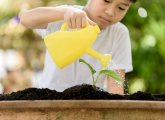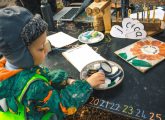Children love monsters, but as adults we can sometimes lose that sense of playful adventure. Our ability to accept the unacceptable becomes stifled. Rediscover the messy, wild, and imaginative world of monster books with these great selections, plus accompanying activity ideas…
Based on a traditional Brazilian poem about a child being born, this quirky book is full of twists and turns, as readers guess what the monster does next.
Read the book together, and encourage the group to make some noise every time you say the word ‘monster’.
Pick out other interesting phrases and words, and give children an action or sound that they can repeat.
For example, when they hear ‘boogie woogie’, they could dance and wiggle, and when they hear ‘porridge’ they could stir the porridge together.
Pick four or five monster shapes that you can easily trace onto plain paper, and photocopy a pile. Ask the children to decorate the monsters by colouring them in and dressing them up.
For example, they might want to add a hat, socks or Wellington boots, or give their characters colourful hair or sunglasses.
When you’ve assembled a full collection of pictures, mix them up in a pile and play a game of snap by asking the children to match the monster shapes.
In the story, the monster goes to school. Tell your group that they’re going to create a school for little monsters. Consider what kind of monsters go there, and what they learn.
What sort of activities might they be involved in, and what games might they play? Encourage the children to draw a picture of the school and the monster pupils.
Ask them how this school might be different from a normal school. Perhaps the monsters learn to scare people, or to growl and roar.
Finish by playing a monster game of hide and seek. Hide the monster pictures around the room. Each child must catch as many little monsters as they can.
This amusing tale is a firm favourite. A clever mouse outwits his predators by using a made up monster called the Gruffalo. But the twist is that the Gruffalo really does exist!
The beautiful rhyming prose enhances the story, making it a pleasure to read with small children.
Go through all the animals in the story, from the mouse to the snake, and make up a simple song. So you might say, “One little mouse went squeak, squeak, squeak. One little owl went screech, screech, screech”.
Finish with “One big Gruffalo went gruff, gruff, gruff!” Encourage babies to join in and make lots of noise, then put the song to music.
Using the large picture of the Gruffalo in the book, encourage the group to get counting. Start by asking children to count how many horns the creature has, then count out loud together.
Do the same for arms, legs, teeth, ears, eyes, nails, tails and the prickles on his back, etc. Come up with a rhyme that can be repeated easily and which provides some counting practice.
So you might say, “Have you seen the Gruffalo? Then tell me something I don’t know! How many (legs/arms/claws/teeth, etc.) has he got?’
Start a new story with the Gruffalo as the central character. For example, “One day the Gruffalo decides to go for a stroll in the woods. He’s having a great time counting the flowers and skipping along the path, when he notices a rainbow.
“He decides he wants to reach the other side to see if he’ll find a pot of gold. So he steps on the rainbow and the strangest thing happens. The wood disappears and the Gruffalo finds himself standing in a…”
Ask the children to join in and come up with some suggestions as to where the Gruffalo is. Take this a step further and ask them to draw a picture to illustrate what happens next.
First published in 1963, this famous tale is about a naughty boy called Max who sails to the land where the wild things live.
The monsters make him their king, but Max misses home much more than he thought, and returns just in time for supper.
In the story, Max looks like a monster thanks to his pyjamas. Create a classroom full of little monsters by encouraging little ones to play dress up and make monster noises.
Introduce monster movements from crawling to jumping, to wiggling and shuffling on all fours.
If you want to take this a step further, create a monster dance by placing words together in an easy rhyme. So, you might say:
Monster roars, and monsters claws.
Monster jumps, and monster growls.
Monster wiggles and monster howls.
Monster claps with a one, two, three.
Monster dances just like me!
This simple rhyme has lots of movements and sounds that young children can join in with.
In this monster book, Max is whisked away to the land of the wild things when a forest begins to grow in his bedroom. Talk about the kinds of things that you might find in a forest, from trees, plants, flowers, and streams, to the creatures that live there.
Explain that you’re going to grow a forest in the classroom. Split the children into smaller groups and let them decide which bit they’re going to create.
For example, one group might work on a giant tree collage, while another could make some tiny woodland animals using play dough.
Rearrange the space and position all of the things in the forest, and then use it as a setting for some magical storytelling.
Get the group to imagine that they’re in the land of the wild things. They must think of a name for this new land and describe their surroundings using key words and pictures.
Ask them to imagine that they are king or queen for a day. As leader, they must create three new rules for this magical land.
So they might decide that you can only eat chocolate all day, or that when people meet for the first time they must ‘high five’ or clap their hands.
Take it in turns to reveal these new laws and, wherever possible, act them out.
Alison Davies is a creative practitioner and author of titles such as Using Festivals to Inspire and Engage Young Children: A Month-by-Month Guide, Reading to Your Baby and Read Me a Story.

Schematic play
Editors picks

Outdoor maths activities – Marvellous muddy maths ideas
Editors picks
